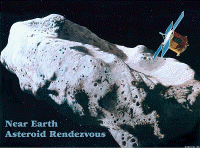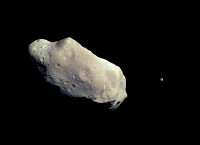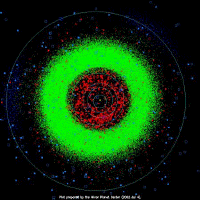About asteroids
Four spacecraft have examined asteroids at close quarters. Three of these obtained snapshots of their rocky targets as they flew past at high speed. Only the NEAR Shoemaker spacecraft has so far entered orbit around an asteroid (Eros), made long-term observations, and landed on an asteroid.
For a long time, the only scientific data obtained about asteroids was through Earth-based observations and photographs. More recently, radar observations have been made of several asteroids as they pass close to the Earth. These revealed that not all asteroids are single objects. Some are 'doubles', with two similarly sized space rocks orbiting one another.
A major breakthrough in studying asteroids came in 1983 with the Infrared Astronomy Satellite (IRAS), a joint effort by the United Kingdom, the Netherlands, and the United States. This satellite observed more than 1800 asteroids. Among them was an unusual asteroid, 3200 Phaethon, which seems to be an extinct comet. Near-Earth asteroids are those that are not confined to the main-belt asteroids but which draw close to our planet. According to theoretical studies, almost 50% of these near-Earth asteroids may be extinct comets. For this reason, astronomers usually refer to them as near-Earth objects.
In 2002, studies of ESA's Infrared Space Observatory, ISO, satellite data archive revealed that there may be up to twice as many asteroids in our Solar System as astronomers had previously thought. Many are so dark that astronomers could not see them in optical surveys. ISO saw them all because it operated in the infrared wavelength. It is now estimated that there are between 1.1 million and 1.9 million asteroids with a diameter of more than 1 kilometre in the main belt.
Asteroids come in many shapes and sizes. Here the large main-belt asteroid Ida is shown with its much smaller moon, Dactyl. The Galileo spacecraft took this enhanced colour image on 28 August 1993.
These rocky objects are also known as 'minor planets' because, although they orbit the Sun in similar ways to the planets, they are too small to be considered the equivalent of Earth and Jupiter.
Being small, they can only be seen as points of light in telescopes. This led British astronomer William Herschel to coin the term asteroid - from a Greek word meaning star-like - to describe this new class of celestial objects.
 Where are asteroids found?
Where are asteroids found?
A map showing the distribution of all known asteroids between the orbits of Mercury and Jupiter. The orbits of the planets are shown in light blue. Green circles show the asteroids. Red circles show objects that approach to within 1.3 times the Earth's distance from the Sun. Objects observed over several orbits are indicated by filled circles. Objects seen at only one opposition, that is, at an apparent position where they are directly opposite the Sun, are indicated by outline circles. The two 'clouds' of objects 60° ahead and behind Jupiter along its orbit are the Jupiter Trojans, here coloured deep blue. Comets are shown as squares. (From the Minor Planet Centre,
http://cfa-www.harvard.edu/iau/lists/InnerPlot.html)
Nearly all of the asteroids are contained within a doughnut-shaped region between the orbits of Mars and Jupiter. On the inner edge of this main asteroid belt, asteroids take about three years to orbit the Sun, while those near the outer limit of the main belt take twice as long.
Although there are thousands of millions of asteroids, the region they occupy is so vast that most of them are separated by thousands of kilometres of empty space. However, since they usually follow elliptical orbits, collisions can still occur.
Scientists think that there is a main asteroid belt because of the strong gravitational influence of the giant planet, Jupiter. At the time of the Solar System's formation, so-called protoplanets, which are objects that collide and stick together to form planets, were growing into today's planets throughout
the Solar System but Jupiter's gravity prevented this from happening in the asteroid belt.
Astronomers believe that around 640 protoplanets existed there but instead of colliding gently and merging, Jupiter's gravity disturbed them, causing them to strike one another forcefully and break up, over thousands of millions of years. Although a large amount of material was lost, the remnants form the main belt today.
 Asteroids and meteorites
Asteroids and meteorites
Meteorites, pebble-, and boulder-sized objects that fall to Earth are usually asteroid fragments, which have broken off larger bodies during collisions. By studying these meteorites, scientists have learned that the asteroids are about 4.6 thousand million years old. They are leftovers from the formation of the Solar System and carry a wealth of information about conditions in the dust cloud that surrounded the Sun when the planets were born.



